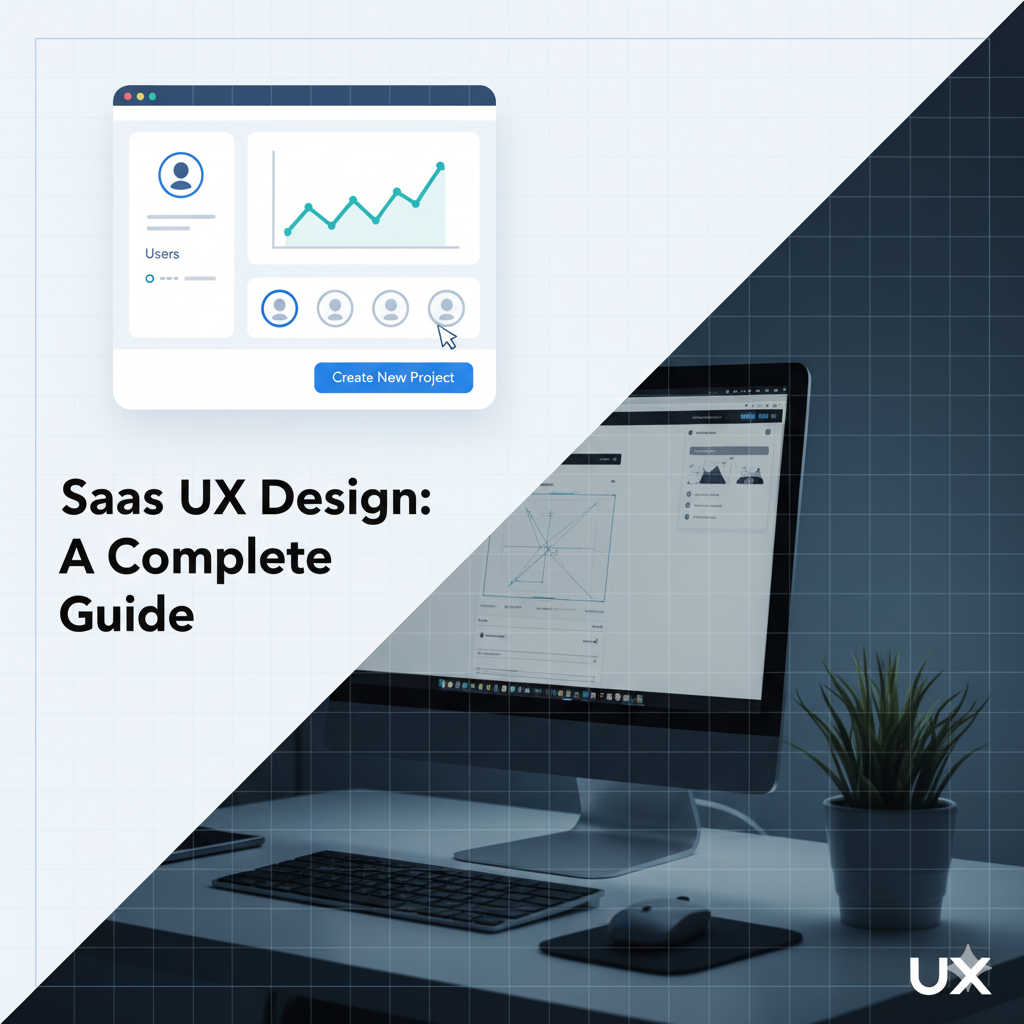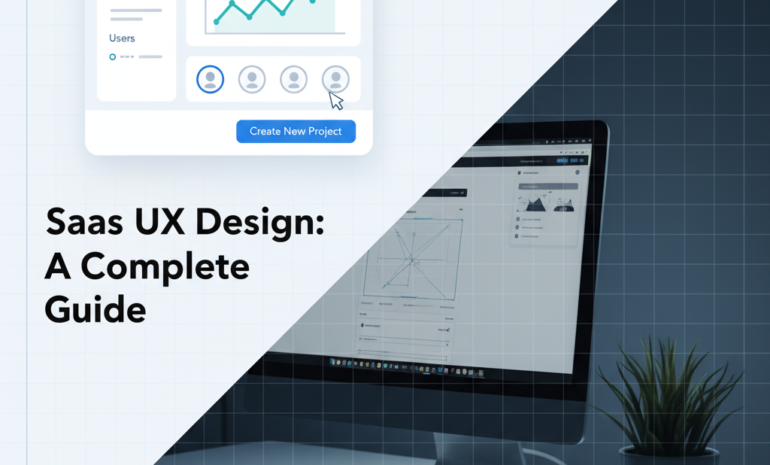SaaS UX design shapes how users feel, think, and act when they interact with your product. It defines whether they continue exploring your platform or leave within minutes.
A smooth experience makes users trust the tool, while a confusing one pushes them away, no matter how strong the features are.
For business owners, SaaS UX is more than just design. It’s the structure that decides conversions, retention, and long-term growth.
From how a new user signs up to how they complete their first task, every click counts. This guide breaks down how the best SaaS UX turns complexity into clarity and helps your software stand out in a crowded market.
Understanding What SaaS UX Means
SaaS UX isn’t just about how your product looks, it’s about how it feels, behaves, and helps users achieve something without friction. When users open a SaaS platform, they aren’t here to explore; they’re here to complete tasks that solve a business problem.
A well-built SaaS UX focuses on reducing the time, confusion, and frustration between sign-up and success.
For business owners, understanding SaaS UX means thinking beyond colors and buttons. It’s about designing every step, from the first interaction to the recurring use, so customers feel confident, supported, and valued.
No matter if it’s a CRM, project management app, or invoicing tool, the success of your product depends on how effortlessly people can use it.
A SaaS platform with strong UX doesn’t just attract users; it keeps them. Great experience builds trust, and trust builds retention. That’s the foundation of a profitable SaaS business.
Why SaaS UX Design Matters for Business Growth
Your SaaS product might have every feature your competitors have, but if your users struggle to understand them, they’ll leave. SaaS UX decides how fast a trial user becomes a paid customer and how often they return to use your product.
When users face hurdles, their frustration turns into churn. Every click that confuses them pushes them toward a competitor. On the other hand, a smooth experience drives conversions, engagement, and lifetime value. This is why companies with the best SaaS UX often grow faster even if their features are similar to others.
A business owner who invests in UX design is actually investing in higher retention and lower acquisition costs. Because every satisfied customer becomes a marketing channel, sharing the product naturally through referrals or reviews.
Core Principles Behind the Best SaaS UX
Simplicity Over Everything
SaaS products are usually feature-heavy, but simplicity wins. A cluttered interface with too many options overwhelms users. They should never feel lost or overloaded. Clear navigation, minimal steps, and guided paths help users focus on what really matters.
Consistency Across the Platform
Buttons, icons, typography, and layout need to stay consistent. If your dashboard uses different patterns in different sections, users start questioning your reliability. Consistency builds comfort. When users know what to expect, they act faster.
Clear Value Communication
From your homepage to your dashboard, every screen should remind users of the value your SaaS brings. Highlight results, not features. When users can see progress or outcomes clearly, they’re more likely to stay.
Speed and Responsiveness
SaaS users expect fast, responsive tools. Long load times or lag create irritation, especially for B2B users managing multiple tasks. A few seconds of delay can feel like minutes in their workday.
Human-Centered Feedback
Every action should trigger a helpful response. When users click a button or finish a task, visual or textual feedback confirms that the system understood their action. It keeps them confident while using your product.
The Role of SaaS Onboarding UX in User Retention
Onboarding is where your users decide whether your product is worth their time. The best SaaS UX starts right here. Many products lose customers not because of weak features, but because users don’t understand how to use them.
A strong SaaS onboarding UX helps new users understand what they need to do first. It’s not about showing every feature; it’s about guiding them toward their first success moment. That’s when they feel the “aha!” moment, the point where they realize your tool is valuable.
You can create this through:
- Interactive walkthroughs that demonstrate the main actions.
- Empty state screens that explain what to do next.
- Progress checklists that celebrate small wins.
- Tooltips that appear only when needed.
The goal isn’t to teach everything, it’s to remove confusion. The faster a user reaches success, the higher the chance they will become a paying customer. A well-built SaaS onboarding UX is your best conversion weapon.
How to Design a SaaS UX That Converts
Start with Research
You can’t design good UX without knowing your users. Study how they think, what problems they face, and what solutions they have already tried. Interviews, surveys, and behavioral analytics reveal pain points that can shape your design strategy.
Define Clear User Flows
Map how users move from one stage to another. Every step should lead to a goal. If they hit a dead end or confusion point, you lose momentum. The best SaaS UX feels like a guided journey rather than a random maze.
Use Visual Hierarchy
Arrange elements based on importance. Headlines, call-to-actions, and notifications should stand out naturally. A clean hierarchy helps users scan, decide, and act quickly.
Design for Emotions
Good UX connects emotionally. Use positive micro-interactions, success animations, and friendly language. It’s not just about usability, it’s about making users feel they belong to something reliable.
Test Everything
UX design is not one-time work. Test onboarding flows, CTA placements, and navigation patterns. A/B testing shows what works best. Data-driven design decisions always outperform assumptions.
SaaS UX Design Mistakes That Cost You Customers
Even experienced SaaS teams make UX mistakes that silently kill conversions. Avoid these common traps:
Overloaded Dashboards
You don’t need to show every metric or feature at once. Clutter creates confusion. A focused dashboard with clear actions performs better than a data-heavy mess.
Complicated Onboarding
If users need to watch tutorials before using your tool, you’ve already failed them. Make the interface self-explanatory through design, not instruction.
Ignoring Mobile Experience
A large portion of SaaS users access tools through phones or tablets. A poor mobile UX limits your reach and drops engagement drastically.
Too Many Pop-Ups or Alerts
Constant interruptions ruin flow. Use alerts only when necessary, and keep them contextual.
Neglecting Error Handling
If users face an error and your system doesn’t explain what happened or how to fix it, they leave. Friendly error messages show care and professionalism.
Building the Best SaaS UX Through Continuous Improvement
Great UX design is never finished. SaaS products evolve with time, and so do user expectations. The best SaaS UX designers treat their platform as a living product that grows with its audience.
Collect user feedback through in-app surveys or support tickets. Observe where users hesitate or drop off. Then improve those sections step by step. Every small improvement compounds into major retention growth.
Add analytics tools like Hotjar or Mixpanel to track behavior. See where users pause, rage-click, or abandon pages. That data is gold for refining user flows.
How SaaS UX Impacts Conversions and Revenue
You can’t separate UX from growth. Every friction point in the interface directly affects conversions. A confusing pricing page lowers sign-ups. A difficult onboarding experience kills upgrades. Poor UX in billing or settings leads to cancellations.
Businesses with a focus on UX often see measurable growth because users stay longer and engage more. Good UX shortens the path between curiosity and loyalty. When users love using your platform, marketing costs drop since they bring others naturally.
Think of UX as your silent salesperson. It works every day, converting users without words.
SaaS Onboarding UX Examples That Work
Some SaaS companies have nailed onboarding. Learning from their patterns can inspire your own strategy.
Slack
Slack’s onboarding is conversational. It doesn’t throw you into a blank workspace. Instead, it walks you through creating channels, sending messages, and inviting teammates. Each action feels natural.
Notion
Notion gives users templates instead of explanations. It shows what’s possible before asking you to build something. That reduces the fear of starting from scratch.
Canva
Canva combines visual learning with reward-based onboarding. You complete small design tasks and instantly see results, making the process fun.
Trello
Trello uses its own interface to teach. You learn by doing, not by reading. The UX makes complex project tracking look simple.
Each of these platforms shows that onboarding isn’t about telling; it’s about helping users win quickly.
Creating a Strong SaaS UX Design Process
A solid SaaS UX process doesn’t happen randomly. It follows a structure that connects business goals to user satisfaction.
Discovery Phase
Identify your audience segments. Define their pain points and motivations. Study competitors to understand what users already experience elsewhere.
Information Architecture
Structure your product’s content logically. Make it easy to find and access every feature without deep clicks.
Wireframing and Prototyping
Before designing the final interface, test your ideas through wireframes and prototypes. It saves time and prevents design flaws later.
User Testing
Gather feedback early. Watch users interact with your prototype. Identify patterns in behavior and confusion.
UI Design
Translate your UX wireframes into an interface that looks professional, clean, and brand-aligned.
Iteration and Optimization
After launch, keep testing. Optimize flows, shorten steps, and remove barriers based on actual data.
This continuous cycle helps you stay aligned with changing user needs.
Why Business Owners Should Care About SaaS UX
As a business owner, you might think UX design is purely a designer’s job. But in SaaS, UX is a growth lever. It affects conversions, retention, support costs, and reputation. Every usability issue costs you money.
Investing in a good SaaS UX strategy isn’t just design expense, it’s a business decision. It shapes how customers feel about your brand. When people find your tool easy and satisfying, they stick around, upgrade faster, and recommend it to others.
The companies leading the market today didn’t win just because of features. They won because of clarity, usability, and user trust. Those are UX-driven advantages.
Optimizing SaaS UX for Different Business Models
Different SaaS models require unique UX considerations.
Freemium SaaS
Your UX should balance accessibility with upgrade motivation. Users should see enough value in the free version to stay, but also clear reasons to pay.
Enterprise SaaS
Enterprise users prefer structure, permissions, and scalability. Your UX must feel powerful but organized. Simple dashboards with advanced layers work best here.
B2C SaaS
Focus on delight and simplicity. Reduce steps to get started. Use visuals and quick actions that make people feel progress immediately.
Mobile-First SaaS
Your design must prioritize thumb-friendly navigation, large touch zones, and fast performance. Mobile users need clarity, not complexity.
SaaS UX Metrics You Should Track
You can’t improve what you don’t measure. Track these UX performance metrics regularly:
- Time to Value (TTV): How long users take to reach their first success moment.
- Activation Rate: Percentage of users completing key onboarding steps.
- Feature Adoption Rate: How often users engage with core features.
- Customer Churn: Rate of users leaving your platform.
- Net Promoter Score (NPS): Measures satisfaction and likelihood of referrals.
These metrics reflect how well your SaaS UX is performing beyond just design aesthetics.
Future Trends Shaping SaaS UX
The SaaS UX landscape keeps changing as technology advances. AI, personalization, and voice interfaces are influencing how users interact with software. Products now learn from behavior and adapt automatically.
Some upcoming shifts to keep an eye on:
- Predictive UX using AI suggestions.
- Personal dashboards that adjust to user roles.
- Voice and gesture-based interactions.
- Frictionless multi-device continuity.
Adapting to these trends early gives your product a competitive advantage.
Final Thoughts
SaaS UX design is not decoration; it’s direction. It guides users toward success while silently selling your product. The best SaaS UX design combines clarity, empathy, and constant improvement. When you align UX with your business goals, you turn design into growth.
Users don’t remember every feature, but they remember how your platform made them feel, confident, capable, and satisfied. That feeling defines your brand’s strength in the SaaS market.
If you’re planning to build or refine a SaaS product and want expert guidance that turns complexity into clarity, Brandout can help you create a powerful SaaS UX design that grows with your users and scales your business smoothly.




